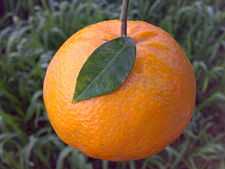Kinnow

The kinnow is a high yield mandarin hybrid cultivated extensively in the Punjab region.
It is a hybrid of two citrus cultivars — 'King' (Citrus nobilis) × 'Willow Leaf' (''Citrus ×deliciosa'') — first developed by Howard B. Frost[1] at the University of California Citrus Experiment Station. After evaluation, the kinnow was released as a new citrus hybrid for commercial cultivation in 1935.[2]
Description
In a hot climate, plants can grow up to 35 feet high.[3] Kinnow trees are highly productive; it is not uncommon to find 1000 fruits per tree.
The fruit matures in January or February. It peels easily and has a high juice content.
Seedless kinnow
_a_hybrid_citrus.jpg)
Kinnow fruits have more seeds per wedge than other citrus fruits. The high seed content of this variety is a major hindrance in out-of-hand eating. Some workers have made efforts to select seedless kinnows by survey or by the use of mutants. The seeds of kinnow are naturally diploid or tetraploid. Seedless triploid varieties have been developed, but these are still undergoing testing to ascertain whether the fruit is healthy for consumption.
Export from Asia
Most of the target export markets of the Pakistani kinnow are those of developing countries. Only 2.6 percent of kinnow exports target the markets of developed countries, which is due to the emerging demand for seedless kinnow by the developed countries. About 61 percent of total world exports of oranges and mandarins are of seedless varieties. Some important export markets for kinnow are: Bahrain, United Arab Emirates, Kuwait, Oman, Qatar, Saudi Arabia, Indonesia, Malaysia, Afghanistan, Netherlands, Philippines, Singapore, the United Kingdom, Russia and Vietnam.[4] Indonesia has also offered market access to kinnow, from Pakistan at zero per cent.[5] Over 40% of the Pakistani exports of kinnows went to Russia in 2015.[6]
Harvesting and handling
Kinnow harvesting starts when the fruit's external colour becomes orange, from December to February. The best harvesting time is mid-January to mid-February, when the fruit attains a TSS/acid ratio of 12:1 to 14:1. The fruit quality declines in later pickings. Fruits are harvested by clipping the stem with the help of sharp clippers (secateurs). The stem is cut as short as possible to avoid mechanical injury to the fruit in packing and transits. As it is a comparatively loose rind fruit, harvesting by pulling fruits with one's hands is avoided. Coating kinnow fruits with commercial waxes can increase the shelf life up to 60 days. The fruit can be stored in cold storage at a temperature of 4-5 °C and a relative humidity of 85-90%.

Fruit processing
Food processing includes the selection of good-quality fruit. The ideal kinnow is firm to slightly soft, smooth-skinned with no deep grooves, and deep orange to almost red. Human hands can better judge and avoid product with soft spots, dull and faded coloring or rough and bumpy skin. Faisalabad Agricultural University in Faisalabad,Pakistan has developed new technologies for obtaining higher yields of better quality fruits under the conditions of Punjab. These fruits can be stored at room temperature conditions or under cold storage conditions.[7]
References
- ↑ Y. H. Hui, M. Pilar Cano, and Josef Barta (Editors). Handbook of Fruits and Fruit Processing. Wiley, John & Sons. 2006. ISBN 978-0-8138-1981-5; page 312.
- ↑ Kinnow at University of California, Riverside Citrus Variety Collection
- ↑ http://newitworld.com/kinnow-stomach-reformer-appetizerblood-purifier-body-recovering-foods-acidity-shooter-boon/
- ↑ Marketing of Fruits Under WTO Regime, Dr. M. Sharif and Burhan Ahmad, Social Sciences Institute, NARC Islamabad
- ↑ "Indonesia, Pakistan ink trade agreement". Investvine.com. 2013-02-17. Retrieved 2013-02-21.
- ↑ Kinnow demand: Over 40% of exports go to Russian market
- ↑ Rattanpal,H.S., Singh Sandeep, Arora Anita and Sangwan, A.K.(2008)Citrus Cultivation in Punjab Harvest and Post-harvest handling of citrus fruits
- India: PepsiCo starts processing of Kinnow in Punjab
- Pakistan: Kinno exports expected to rise with seedless variety in sight
